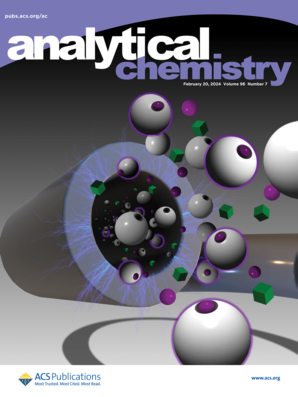Electrochemical Biosensor Utilizing Low-Susceptibility Macrocyclic Stapled Peptide to Mitigate Biofouling for Reliable Protein Detection in Human Serum
IF 6.7
1区 化学
Q1 CHEMISTRY, ANALYTICAL
引用次数: 0
Abstract
Antifouling peptide surfaces have garnered increasing attention due to their immense potential across various biochemical fields. Cyclic peptides, in particular, demonstrate greater resistance to nonspecific substance adsorption compared to regular linear peptides. Herein, inspired by the macrocyclization method, we introduced two non-natural amino acids (R8 and S5) to cyclize the typical low-fouling sequence (EKEKEK) head-to-tail, thereby protecting terminal amino acids and reducing proteolytic susceptibility. This approach resulted in the formation of a novel stapled peptide (SP), which resisted protease hydrolysis and enhanced the antifouling capabilities of the SP-based biosensor compared to the conventional linear peptide (LP), demonstrated by electrochemical testing and fluorescence imaging experiments. Theoretically, molecular dynamics simulations were employed to calculate binding energies between the peptides and carboxypeptidase Y (CPY), and the results showcased a stronger binding affinity of LP with CPY, further confirming the lower proteolytic susceptibility of the engineered SP. Remarkably, the SP-based biosensor demonstrated high sensitivity in detecting the model target of carcinoembryonic antigen, with a limit of detection of 0.49 pg/mL. Moreover, clinical serum samples analyzed using the SP-based biosensor showed excellent concordance with hospital diagnostic methods, underscoring its exceptional accuracy and further highlighting the superiorities of the engineered SP structures.

利用低敏感性大环钉肽减轻生物污染的电化学生物传感器用于可靠的人血清蛋白质检测
防污肽表面因其在各个生化领域的巨大潜力而受到越来越多的关注。与普通线性肽相比,环状肽尤其具有更强的抗非特异性物质吸附能力。在此,我们受到大环化方法的启发,引入了两个非天然氨基酸(R8 和 S5),使典型的低堵塞序列(EKEKEK)从头到尾环化,从而保护了末端氨基酸,降低了蛋白水解的敏感性。电化学测试和荧光成像实验证明,与传统的线性肽(LP)相比,这种方法形成了一种新型的钉状肽(SP),它能抵抗蛋白酶的水解,并增强了基于 SP 的生物传感器的防污能力。理论上,采用分子动力学模拟计算了肽与羧肽酶 Y(CPY)之间的结合能,结果表明 LP 与 CPY 的结合亲和力更强,进一步证实了工程 SP 的蛋白水解敏感性更低。值得注意的是,这种基于 SP 的生物传感器在检测癌胚抗原模型目标物方面表现出极高的灵敏度,检测限为 0.49 pg/mL。此外,使用基于 SP 的生物传感器分析的临床血清样本与医院的诊断方法显示出极好的一致性,突出了其卓越的准确性,进一步彰显了工程 SP 结构的优越性。
本文章由计算机程序翻译,如有差异,请以英文原文为准。
求助全文
约1分钟内获得全文
求助全文
来源期刊

Analytical Chemistry
化学-分析化学
CiteScore
12.10
自引率
12.20%
发文量
1949
审稿时长
1.4 months
期刊介绍:
Analytical Chemistry, a peer-reviewed research journal, focuses on disseminating new and original knowledge across all branches of analytical chemistry. Fundamental articles may explore general principles of chemical measurement science and need not directly address existing or potential analytical methodology. They can be entirely theoretical or report experimental results. Contributions may cover various phases of analytical operations, including sampling, bioanalysis, electrochemistry, mass spectrometry, microscale and nanoscale systems, environmental analysis, separations, spectroscopy, chemical reactions and selectivity, instrumentation, imaging, surface analysis, and data processing. Papers discussing known analytical methods should present a significant, original application of the method, a notable improvement, or results on an important analyte.
 求助内容:
求助内容: 应助结果提醒方式:
应助结果提醒方式:


